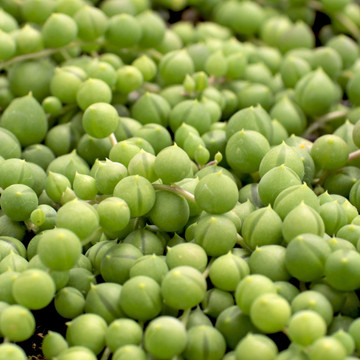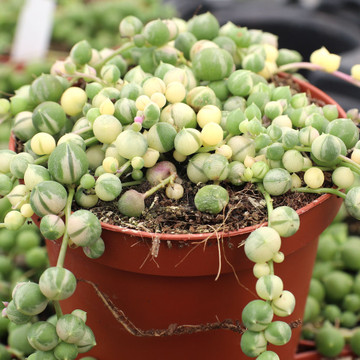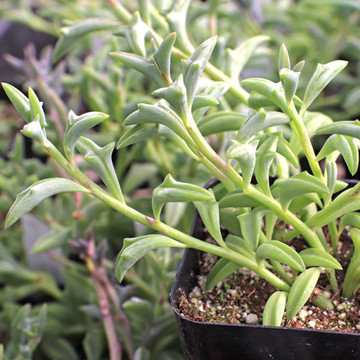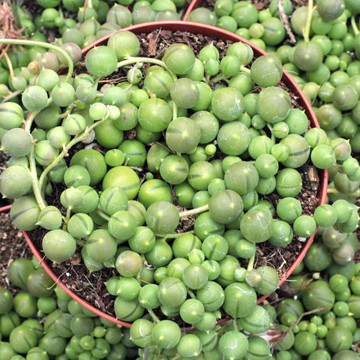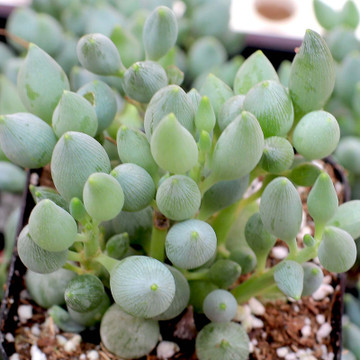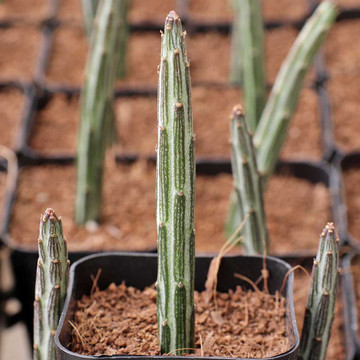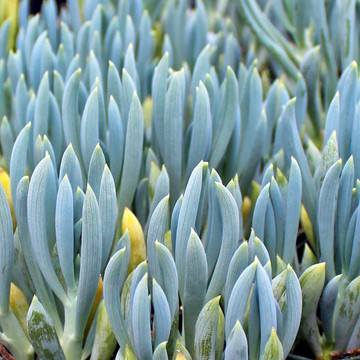Senecio (se-NEE-see-oh) succulents are prized for their unique foliage which can resemble pearls, chalk sticks, and even bananas. There are many different forms to explore in this group, including low-growing, ground cover types and the trailing cascades of "string" varieties. Senecio plants are drought-tolerant and green varieties will thrive indoors, bringing exotic leaf shapes to any planting.
APPEARANCE
- Form: Plant form varies widely, including spreading ground cover varieties that stay under 3", 5"-10" loose rosettes, and 12"+ trailing varieties with stems so thin they resemble string.
- Colors: Most fall in the blue, green, and silver color tones, with some covered by a soft, powdery coating. This coloration lends itself well to underwater-themed plantings.
- Foliage: The fleshy leaves of Senecio can take on many forms, with two favorites resembling pearls (S. rowleyanus) and bananas (S. radicans). Also available are varieties with transparent, green "windows" on their leaves to let in light and others that have no leaves at all.
- Flowers: The blooms can either resemble daisies or paintbrush tips and are colored off-white, orange, red, or purple. Though not considered attractive, they emerge on long stems which are easily removed without harming the plant.
CARE
- Light: Plant outdoor Senecio in partial sun and keep indoor plants in rooms with sunny windows. Keep in mind, blue varieties will require more sunlight to stay vibrant whereas green types can thrive in the lower light found in most rooms. If possible, move pots outdoors when temperatures stay above 40F and bring them back inside before there is a chance of frost.
- Soil: A gritty, well-draining succulent/cactus soil from a garden center will support healthy growth and minimize the chance of rot. To make your own, mix 1 part potting soil, 1 part coarse sand, and 1 part perlite. Fertilizer is not required, but 2-3 light applications in the summer growing season can boost growth.
- Water: Senecio are prone to rot if left in standing water. Water deeply then wait for soil to fully dry before watering again (about 3-7 days). Reduce frequency of watering in the winter when plants are partially dormant and, if possible, plant in containers with drainage holes.
- Hardiness: Senecio are not frost hardy and should only be planted outdoors in zones 10 or 11 where minimum temperatures are above freezing (what’s my zone?). Fortunately for plant lovers in other climates, these plants can thrive indoors year-round or spend just the warm, summer months outdoors.
- Propagation: Stem and leaf cuttings from this group are particularly successful at re-rooting. Use a sharp, clean knife to remove a large leaf or the top 2″+ of stem. Leave to dry 3-5 days, then follow our Guide to Propagating Cuttings.
NOTES FROM THE NURSERY
Though the whole Senecio genus contains over 1,000 species, only about 100 are "succulent" or water-storing. They are classified in the aster family along with their succulent relatives Othonna, including 'Little Pickles' (O. capensis). Most Senecio succulents are native to Africa and some of their unique attributes are in fact adaptations to their semi-arid habitats. Powdery and felt-like coatings protect them from over-exposure to the sun while long, trailing stems allow them to cover more area in search of water.
In cultivation, Senecio is an easy grower and will tolerate limited water, indoor light (green varieties), and lean soil. A forgiving but distinctive group of plants, Senecio varieties are great options for both succulent beginners and long-time enthusiasts looking to diversify their collections.
READ MORE
